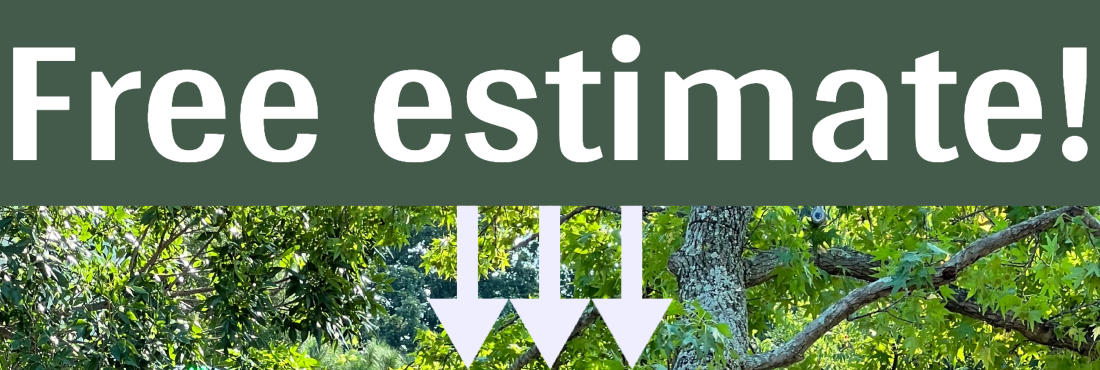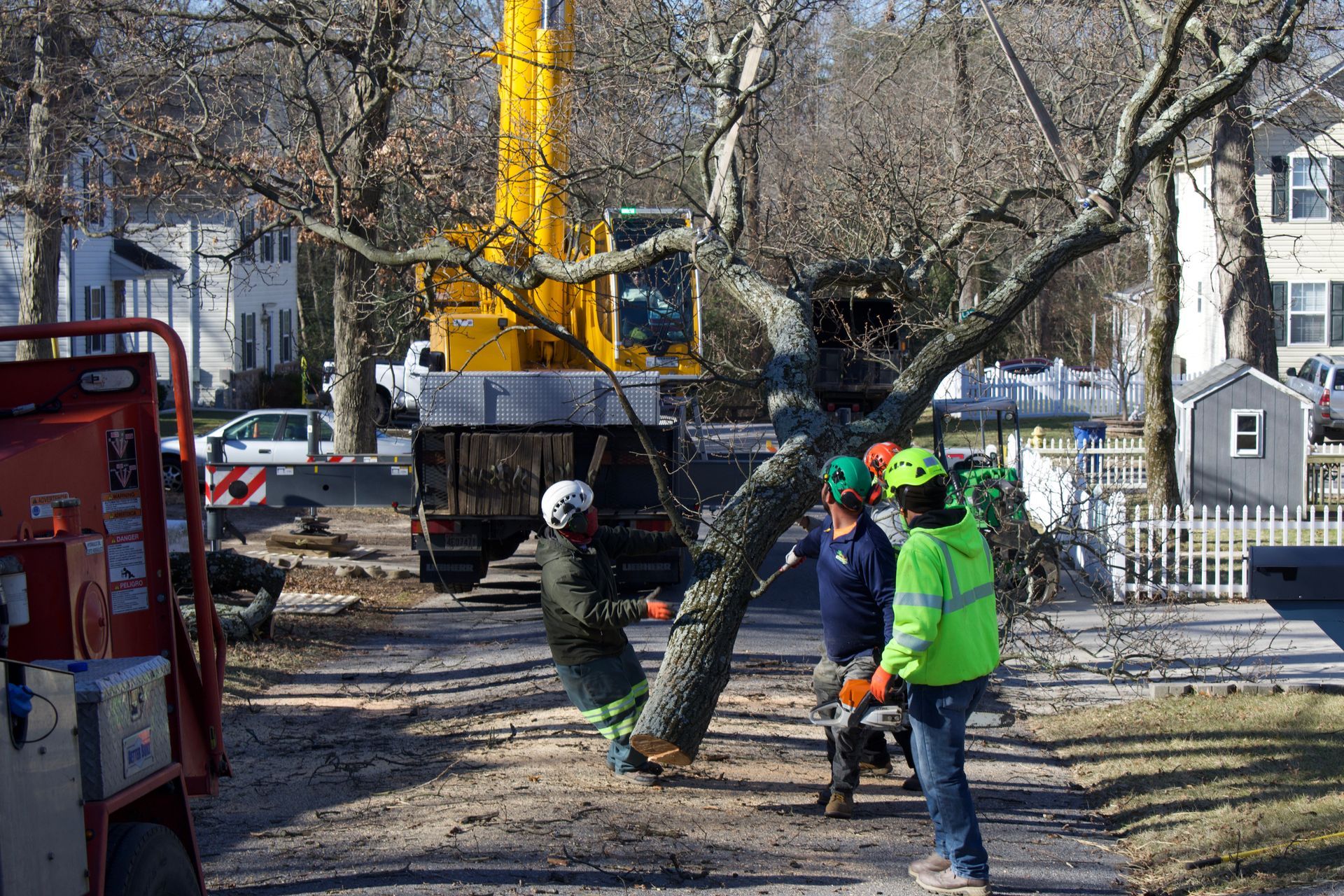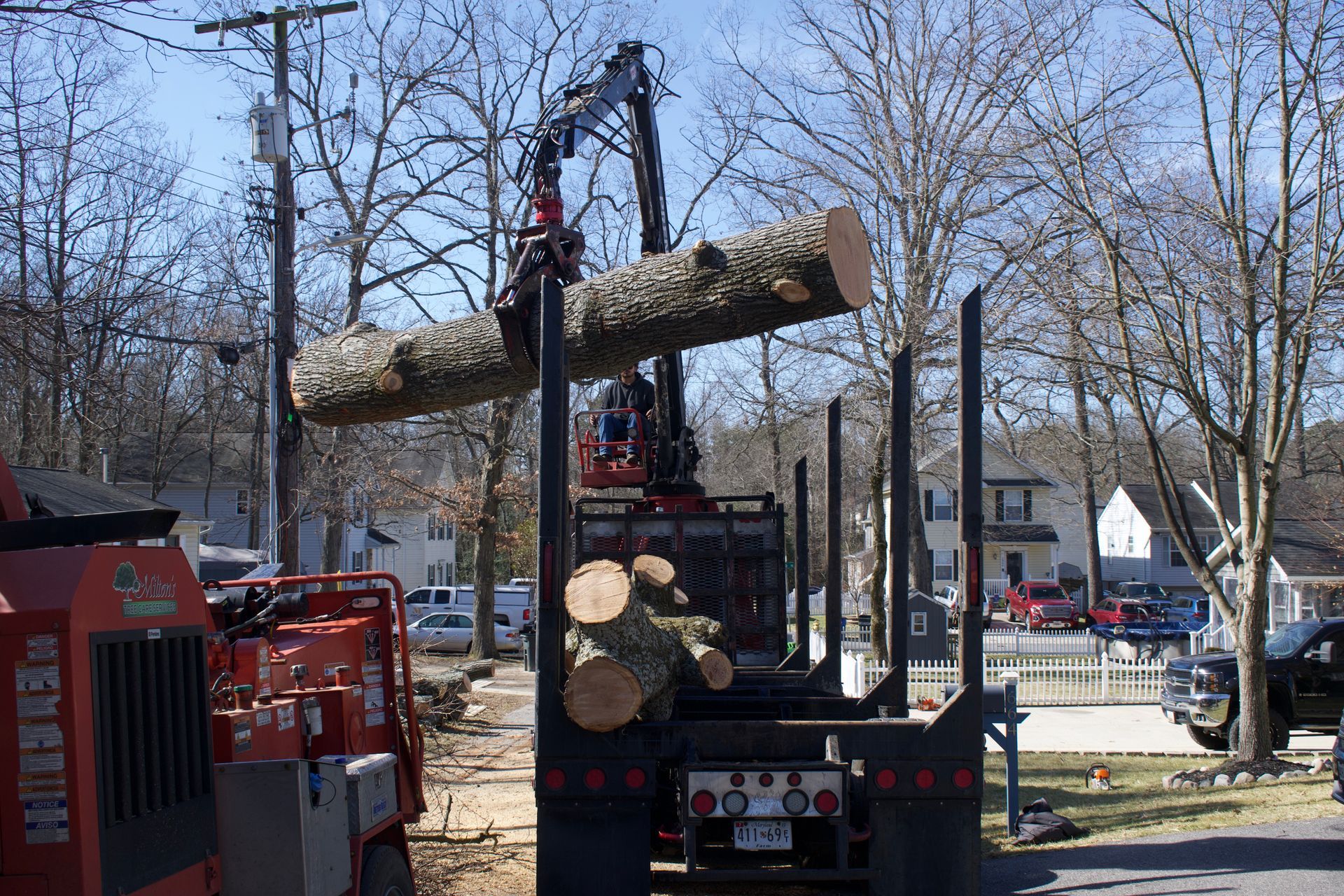Tree Removal in Upper Marlboro MD & surrounding areas
*Emergency Services Available, Call Us Now* 301-675-8147
At Milton's Tree Care Services LLC, we pride ourselves on offering comprehensive
tree removal services in Upper Marlboro, MD tailored to the unique needs of our clients. From initial assessment to meticulous execution and cleanup, our team is dedicated to ensuring a seamless and stress-free experience for every customer. Whether it's a matter of safety, aesthetics, or land development, the expertise of our arborists becomes invaluable.
Initial Assessment and Consultation
Before any tree removal project commences, our team conducts a thorough assessment of the site. We evaluate the health, size, and condition of the tree(s) in question. This initial consultation allows us to understand the client's requirements, address concerns, and formulate a tailored plan of action.

We will get back to you as soon as possible.
Please try again later.
Safe and Efficient Tree Removal
Safety is paramount in our tree removal process. Our certified arborists utilize state-of-the-art equipment and industry-best practices to ensure the safe and efficient removal of trees of any size or complexity. From precarious overhanging branches to entire trees posing risks to property or individuals, we handle each removal with precision and care.
Environmentally Conscious Practices
As stewards of the environment, we are committed to minimizing our ecological footprint. Our tree removal services prioritize eco-friendly practices, including proper disposal of green waste and recycling of wood materials. Additionally, we adhere to local regulations and guidelines to preserve the natural integrity of Upper Marlboro's landscape.
Stump Removal and Grinding
Complete tree removal involves more than just felling the tree. Unsightly stumps can mar the beauty of a landscape and pose tripping hazards. Our services extend to stump removal and grinding, leaving your property clear and ready for whatever landscaping plans you have in mind.
Emergency Service
Nature can be unpredictable, and emergencies such as storm damage or sudden tree collapse require immediate attention. Our team is available 24/7 to respond to such crises, providing swift and effective tree removal services to mitigate further damage and ensure the safety of your property.
Post-Removal Clean-Up
A tidy landscape is the final touch to a successful tree removal project. We meticulously clean up debris, branches, and any remnants of the removal process, leaving your property looking pristine and rejuvenated.
Customized Maintenance Plans
Beyond removal, we offer ongoing maintenance plans to keep your landscape flourishing. From tree trimming to disease prevention, our services are tailored to promote the health and longevity of your remaining trees, ensuring a vibrant and sustainable ecosystem.
Tree Removal Near You
Tree removal is more than just a service—it's a partnership in preserving the natural beauty and safety of our surroundings. Our commitment to excellence, safety, and environmental stewardship sets us apart as the premier choice for tree removal services in the region. Whether you're a homeowner, business owner, or property manager, trust us to transform your landscape with professionalism and care. Contact us today to schedule a consultation and experience the difference firsthand.
Choose our tree experts for all your tree care needs. We offer services like tree trimming and cutting, pruning, stump removal and grinding, emergency tree removal, and professional arborist care. Trust us to keep your trees healthy and your property safe!

Exploring Tree Removal: Traditional Methods vs. Modern Techniques
Tree removal is a task that has been undertaken for centuries, evolving from traditional methods to more modern and efficient techniques. In this blog, we delve into the differences between traditional and modern tree removal methods, highlighting their respective advantages and disadvantages.
Traditional Tree Removal Techniques
-
1. Hand Tools:
- Traditional tree removal often involved the use of hand tools such as axes, saws, and hatchets.
- These tools required significant manual labor and were time-consuming.
- While effective for small trees and branches, they were inadequate for larger trees.
-
2. Controlled Cutting:
- Traditional methods also employed controlled cutting techniques, where specific branches or sections of the tree were targeted.
- This required skilled labor and careful planning to avoid damage to property or injury.
-
3. Climbing:
- Climbing trees to remove branches or cut down the tree itself was another traditional technique.
- This method was hazardous and required experienced climbers, often posing safety risks.
-
4. Advantages:
- Low cost, as they require minimal equipment.
- Suitable for small-scale tree removal tasks.
-
5. Disadvantages:
- Time-consuming and labor-intensive.
- Higher risk of accidents and injuries.
Modern Tree Removal Techniques
-
1. Mechanized Equipment:
- Modern tree removal techniques leverage mechanized equipment such as chainsaws, wood chippers, and cranes.
- These tools significantly expedite the process and reduce manual labor requirements.
-
2. Rigging Systems:
- Rigging systems are commonly used in modern tree removal to safely lower branches and sections of the tree to the ground.
- This minimizes the risk of property damage and ensures the safety of workers and bystanders.
-
3. Advanced Climbing Gear:
- Modern climbers utilize advanced climbing gear such as harnesses, ropes, and safety helmets.
- These tools enhance safety and efficiency, allowing climbers to navigate trees with greater ease and precision.
-
4. Advantages:
- Greater efficiency and speed.
- Enhanced safety measures reduce the risk of accidents.
-
5. Disadvantages:
- Higher initial investment in equipment and training.
- May not be accessible in remote or rugged terrain.
In conclusion, the evolution of tree removal techniques from traditional methods to modern technologies has revolutionized the industry. While traditional methods have their merits, modern techniques offer greater efficiency, safety, and precision. Ultimately, the choice between traditional and modern tree removal methods depends on factors such as scale, budget, and safety considerations.

Understanding the Whys Behind Tree Removal
Trees are undeniably essential for our environment, providing oxygen, shade, and habitat for countless species. However, there are times when the removal of trees becomes necessary. Let's delve into the reasons why tree removal may be required, shedding light on the various circumstances that prompted this decision.
-
Disease and Decay
Trees, like any living organism, are susceptible to diseases and decay. When a tree becomes infested with pests or infected with diseases such as Dutch elm disease or oak wilt, it can pose a risk not only to itself but also to surrounding vegetation. In such cases, removal may be the only viable solution to prevent the spread of illness and preserve the health of the ecosystem.
-
Structural Instability
As trees age, their structural integrity may become compromised due to factors such as root damage, trunk decay, or severe weather events. A weakened tree poses a significant safety hazard, especially if it's situated near structures like homes, power lines, or roads. To mitigate the risk of property damage or personal injury, removal may be recommended to prevent potential disasters.
-
Encroachment and Space Limitations
In urban and suburban areas, trees may outgrow their designated spaces, encroaching upon buildings, sidewalks, or utility lines. While trees are valued for their aesthetic appeal, their unchecked growth can lead to practical problems and safety concerns. In such instances, removal might be necessary to maintain the integrity of infrastructure and ensure public safety.
-
Land Development Projects
With rapid urbanization and expanding infrastructure projects, trees often face displacement due to land development activities. While efforts are made to preserve existing vegetation wherever possible, certain projects may necessitate the removal of trees to accommodate construction needs. In these cases, mitigation measures such as reforestation or landscaping may be implemented to offset environmental impact.
-
Aesthetic Considerations
While it may seem counterintuitive, there are situations where tree removal is desired for aesthetic reasons. Diseased, damaged, or unsightly trees can detract from the visual appeal of a landscape or property. Property owners may opt for removal to enhance curb appeal or create space for new plantings that better complement their design preferences.
-
Risk Assessment and Liability
Property owners have a legal obligation to ensure the safety of their premises. Neglecting to address hazardous trees on their property could result in liability issues if accidents occur. Conducting regular risk assessments and promptly removing trees deemed hazardous can help mitigate potential legal repercussions and safeguard the well-being of residents and visitors.
-
Tree Health and Sustainability
Sometimes, tree removal is necessary to promote the overall health and sustainability of a forest or wooded area. Thinning out overcrowded or unhealthy trees can improve sunlight penetration, soil quality, and biodiversity, facilitating the growth of stronger, more resilient vegetation. Strategic removals may also be part of forest management plans aimed at preserving ecosystem balance and resilience.
In conclusion, while trees are invaluable assets to our environment, there are instances where their removal is justified and even necessary. Whether it's due to disease, safety concerns, development projects, or aesthetic considerations, the decision to remove a tree should be carefully considered, weighing the benefits against the potential consequences. By understanding the reasons behind tree removal, we can strive to strike a balance between conservation efforts and the practical needs of our communities.
GET A FREE ESTIMATE TODAY
At Milton's Tree Care Services LLC, we are committed to providing top-quality tree care solutions tailored to your needs. From tree trimming and pruning to safe and efficient tree removal, our experienced team ensures the health and beauty of your landscape. With a focus on safety, professionalism, and customer satisfaction, we handle every job with care and precision. Contact us today to see how we can help maintain or improve your outdoor space!